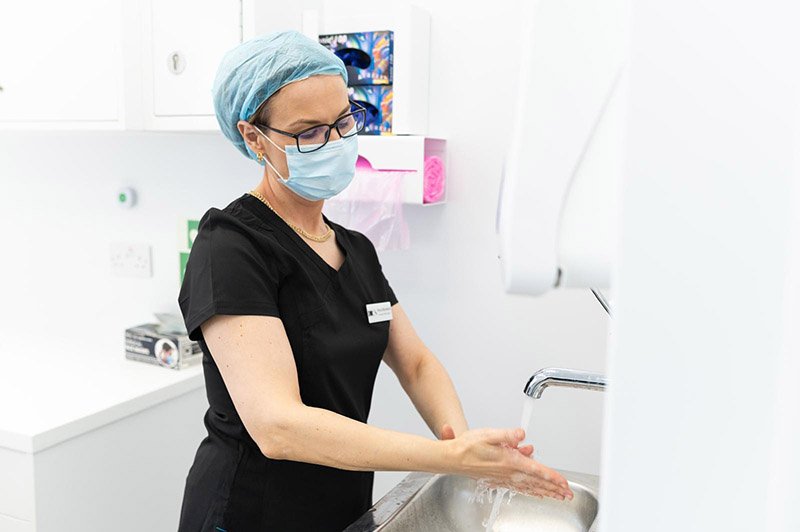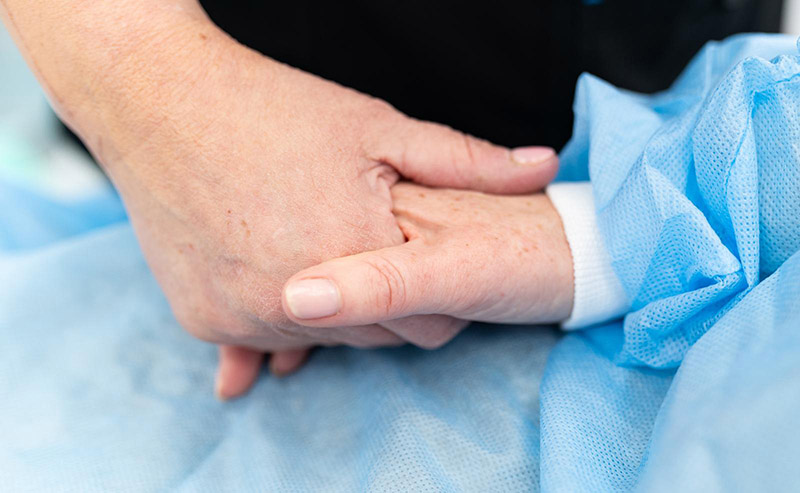
Risks and Complications Information for Patients of Plastic Surgeon Anca Breahna
You have probably heard about plastic surgery, and it’s likely that you know someone who has undergone it. It’s become a common phenomenon in our society, with millions of procedures performed every year worldwide. But, are you aware of the potential plastic surgery risks and complications that come with it? Before you step into the operating room, it’s essential to understand these aspects thoroughly.
Plastic surgery is a significant decision that needs careful thought and consideration. It’s not as simple as just ‘fixing’ or ‘improving’ your appearance. It’s a medical procedure that carries with it certain risks and complications, just like any other surgery. While the outcomes can be positive, the flip side of the coin also needs to be contemplated.
In this page, Chester Consultant Plastic Surgeon Anca Breahna, will discuss the risks that plastic surgery entails, focusing on the potential complications of plastic surgery, and how you can minimise them. Whether you’re considering a breast augmentation, reduction, or a different kind of plastic surgery, it’s important to know what to expect.
What Is Plastic Surgery?
Before getting to the risks, let’s first understand what plastic surgery is. In simple terms, it’s a specialised branch of surgery that involves repairing or reconstructing parts of the body. Some people opt for plastic surgery for medical reasons, such as after a mastectomy or to repair injuries from accidents. Others choose it for cosmetic reasons, to enhance their physical appearance.
It’s important to remember that the term ‘plastic’ in plastic surgery doesn’t mean artificial. It comes from the Greek word ‘plastikos’, which means to shape or mould. So, plastic surgery is essentially about reshaping or remodelling parts of the body.
However, despite its popularity and the advances in medical technology, plastic surgery is not without risks. It’s a serious decision that requires a thorough understanding of what’s involved, including the potential plastic surgery risks and complications.
General Complications that Can Occur after Plastic Surgery
While many of these risks are common across different surgical procedures, the likelihood of each risk can vary based on the specific surgery, the plastic surgeon’s expertise, the patient’s health status, and post-operative care. It’s essential for patients to have a thorough discussion with Anca Breahna about potential risks and benefits before undergoing any surgical procedure.
Here are some general complications that could occur after plastic surgery interventions:
- Scarring: Virtually all surgeries involve incisions, which can lead to scarring. The size, location, and appearance of scars will vary based on the procedure and individual healing factors.
- Infection: Any surgical procedure that involves making incisions or penetrating the skin carries a risk of infection. Proper wound care and sterile surgical techniques are crucial to minimise this risk.
- Blood Clots: Surgeries, especially those that involve prolonged immobilisation or are more invasive, can increase the risk of blood, which can potentially travel to the lungs, resulting in a pulmonary embolism. This risk is present in many surgeries, particularly those involving the lower extremities, pelvis, or lengthy operative times.
- Poor Wound Healing: Any surgery that requires an incision can lead to issues with wound healing. Factors like smoking, underlying health conditions, poor nutrition, or complications during the procedure can contribute to delayed or poor wound healing.
- Fluid Accumulation (Seroma): Seromas can develop after many types of surgeries, especially those that involve the removal of tissue, creating a potential space for fluid accumulation. Procedures like breast augmentation, liposuction, and facelifts can also have this risk.
- Numbness or Altered Sensation: Surgeries that involve cutting near nerves can result in temporary or permanent changes in sensation. This is common in procedures like breast surgeries, facelifts, and certain orthopaedic surgeries.
- Unfavourable Cosmetic Outcome: Any cosmetic surgery carries the risk of not meeting the patient’s expectations in terms of appearance. This can be due to factors like individual healing, surgical technique, or post-operative complications.
- Anaesthesia Risks: Any procedure that requires anaesthesia, whether general or local, carries potential risks. These can include allergic reactions, breathing difficulties, and other anaesthesia-related complications.
- Chronic Pain: While pain is expected after surgery, chronic pain that persists long after the expected healing time can occur with various procedures, especially if there are complications or nerve involvement.
- Tissue Necrosis: The risk of tissue death or necrosis is present in surgeries that might compromise blood flow to a particular area. This is especially a concern in procedures like skin grafts, facelifts, or surgeries in areas with limited blood supply.
- Complications with Sutures: Any surgery that requires sutures, whether internal or external, carries the risk of suture-related complications. These can include suture breakage, migration, or allergic reactions to suture material.
Specific Risks and Complications of Plastic Surgery
It’s important to understand that different types of plastic surgeries come with specific risks. For example, the risks of breast augmentation and blepharoplasty risks can vary significantly. Here are some specific risks of different plastic surgery procedures:
Risks of Tummy Tuck Surgery
These include the potential for an unfavourable cosmetic outcome, such as asymmetry or unsatisfactory scar placement. There’s also the risk of fluid accumulation (seroma) in the surgical area, which may require drainage. Numbness or altered sensation around the surgical site is common and can be temporary or, in rare cases, permanent. Additionally, tissue necrosis, where the tissue in the operated area doesn’t receive adequate blood flow leading to tissue death, is a concern, especially among smokers.
Liposuction Risks and Potential Complications
Common side effects include bruising, swelling, and temporary numbness in the treated areas. More serious complications can encompass infections, fluid accumulation (seroma), and there’s also the risk of contour irregularities, where the skin may appear bumpy, wavy, or withered due to uneven fat removal or poor skin elasticity. In rare cases, a fat embolism might occur, where loosened fat enters the bloodstream and travels to the lungs or brain.
Breast Augmentation Risks and Complications
Common concerns include scarring, pain, and changes in nipple or breast sensation, which can be temporary or permanent. There’s also the risk of implant complications such as rupture, where the implant breaks or leaks, and capsular contracture, where scar tissue forms around the implant, causing it to harden and become misshapen. Over time, implants may shift, leading to asymmetry or an undesirable appearance. Infections, although rare, can occur post-operatively. Additionally, breast implants don’t last a lifetime and may require replacement or revision surgeries in the future.
Breast Surgery – Breast Reduction, Breast Lift, Fat Transfer to the Breasts Risks
Breast surgeries, encompassing breast reduction, breast lift, and fat transfer to the breasts, are procedures designed to reshape, resize, or enhance the breasts. Each comes with its unique set of potential risks and complications:
- Breast Reduction: Aimed at reducing the size of overly large breasts, potential risks include scarring, asymmetry between the breasts, and changes in nipple or breast sensation. There’s also the possibility of complications with breastfeeding in the future Breast Lift (Mastopexy): This procedure lifts sagging breasts to a more youthful position. Risks include scarring, potential loss of nipple sensation, and asymmetry. As with other surgeries, there’s a chance of poor wound healing, especially in areas where the skin is sutured together
- Fat Transfer to the Breasts: This involves removing fat from one part of the body (usually the abdomen or thighs) and injecting it into the breasts. Risks include fat necrosis, where the transferred fat cells don’t survive, leading to the formation of small, hard lumps. There’s also the possibility of uneven absorption of the fat, resulting in asymmetry. In some cases, the transferred fat might be mistaken for calcifications or breast lumps during mammograms, complicating breast cancer detection
Body Contouring Procedures Risks and Complications (arm lift, thigh lift)
Body contouring procedures, including arm lift (brachioplasty) and thigh lift, aim to reshape and refine the body’s silhouette by removing excess skin and fat. While they can significantly enhance one’s appearance, they are not without potential risks and complications. Scarring is a common concern, as incisions are necessary for both procedures, and the scars, though strategically placed, can still be noticeable. There’s also the risk of asymmetry, where one side may not mirror the other perfectly. Temporary or permanent changes in skin sensation, such as numbness, can occur due to nerve disruption. Additionally, complications like poor wound healing, seromas (fluid accumulation), and infections can arise post-operatively.
Labiaplasty Surgery Potential Complications
Labiaplasty, a surgical procedure aimed at reshaping or reducing the size of the labia minora, has gained popularity for both cosmetic and functional reasons. While many patients report satisfaction with the results, the surgery is not without potential complications. Scarring is a concern, though it’s typically minimal and discreetly located. Changes in sensation or numbness in the treated area can occur, which might be temporary or, in rare cases, permanent. Over-resection or uneven removal of tissue can lead to aesthetic dissatisfaction or functional issues. There’s also a risk of wound separation, prolonged swelling, and infections post-operatively. Complications can impact sexual satisfaction or cause discomfort during intercourse.
How to Minimise the Risks of Plastic Surgery
With careful planning and adherence to guidelines, the risks of plastic surgery can be significantly reduced. Here are some recommendations on how to minimise the potential dangers associated with plastic surgery:
- Choose a Certified and Experienced Surgeon: The importance of selecting a qualified plastic surgeon cannot be overstated. A surgeon like consultant plastic surgeon Anca Breahna is an excellent example of what to look for. Ensure that the plastic surgeon is board-certified by a recognised institution. This certification is an indication of their expertise and adherence to high standards of practice.
- Verify Credentials and Experience: Don’t just take their word for it. Ask for proof of their qualifications. Inquire about their experience, especially concerning the specific procedure you’re considering. A seasoned plastic surgeon will have a wealth of experience and will be more adept at handling any complications that might arise
- Request Before-and-After Photos: These photos offer a visual testament to a plastic surgeon’s work. They can give you an idea of the results to expect and the quality of the surgeon’s work. However, ensure that these photos are of actual patients and not stock images.
- Adhere to Pre- and Post-Operative Instructions: Your plastic surgeon will provide a list of dos and don’ts before and after the surgery. This might include dietary restrictions, avoiding certain activities, and medication guidelines. For instance, smoking can impede the healing process, so it’s recommended to quit or at least reduce smoking before the surgery. Similarly, some medications can increase the risk of bleeding, so they should be avoided.
- Discuss Your Medical History: It’s essential to be transparent about your medical history. Conditions like diabetes, heart diseases, or any allergies can influence the surgery’s outcome. A thorough discussion will help the plastic surgeon tailor the procedure to your specific needs and conditions.
- Maintain a Healthy Lifestyle: A healthy body recovers faster. Ensure you’re eating a balanced diet, staying hydrated, and getting regular exercise. This will not only aid in a smoother recovery but also enhance the results of the surgery.
When to Seek Medical Attention after Plastic Surgery
Post-operative care is as crucial as the preparation leading up to the surgery. While it’s natural to experience some discomfort, it’s vital to differentiate between normal post-surgery symptoms and potential complications.
- Monitor for Severe Symptoms: Mild pain, slight swelling, and minimal redness might be expected. However, if you experience intense pain, excessive swelling, or deep redness, it’s a cause for concern
- Watch Out for Fever: A fever post-surgery could be indicative of an infection. It’s essential to address this immediately to prevent any further complications
- Stay in Touch with Your Plastic Surgeon: Regular check-ups post-surgery are a must. However, if you notice any unusual symptoms or if something doesn’t feel right, don’t wait for your next scheduled appointment. Reach out to your plastic surgeon immediately
Further Reading about Plastic Surgery with Consultant Plastic Surgeon Anca Breahna
- Read more about Breast Augmentation
- Read more about Tummy Tuck Surgery
- Read more about Labiaplasty
- Read more about Thigh Lift
- Read more about Mummy Makeover


 Ms Anca Breahna, PhD, MSc, FEBOPRAS, FRCS (Plast) is a highly regarded Consultant Plastic Surgeon specialising in the field of Aesthetic and Reconstructive Plastic Surgery. Anca performs a range of
Ms Anca Breahna, PhD, MSc, FEBOPRAS, FRCS (Plast) is a highly regarded Consultant Plastic Surgeon specialising in the field of Aesthetic and Reconstructive Plastic Surgery. Anca performs a range of 